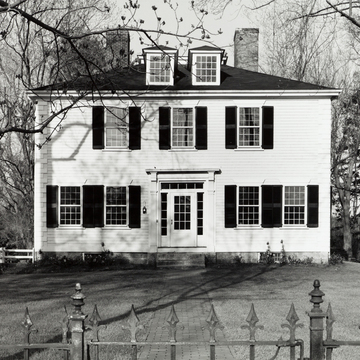Set back in generous grounds is the Soule-Seabury House, which began as a south-facing (toward East Road), center-chimney house, two stories high, with corner quoining. Abner Soule (sometimes spelled Sowle), who erected the house, was a whaler, blacksmith, and Revolutionary War hero. He passed on his blacksmith shops, on the very corner of the house site at the intersection, to one son in 1808; his twin, the famous sea captain, Cornelius, received the house and farm (he soon controlled the blacksmith shops as well). Immediately, Cornelius more than doubled the original house. The 1809 addition to the north made a square of the previously rectangular house and added a dormered, hipped roof (rising to a centered platform now minus its railing and an additional balancing chimney). The modernized plan permitted a central hall through the house between the chimneys. The new west front (on Main Road) features a pattern of openings progressively reduced in number from ground story to dormers which is both unusual and visually effective. Five on the first story; three on the second; finally, two dormers squeezed between the two chimneys. Together they impose a pyramidal overlay across the nearly double- squared field of the elevation. The old front (toward East Road) may have established the pattern—or those dormers may have been altered to agree with the new front. So puzzles remain.
The colorful Cornelius was, however, barely in residence. Active initially in the China trade, he became the skipper of the pride of John Jacob Astor's sailing fleet, the Beaver. In 1811, Soule sailed this vessel from New York with men and supplies to reinforce Astor's newly established fur trading post, Astoria, at the mouth of the Columbia River. He reached Astoria on May














